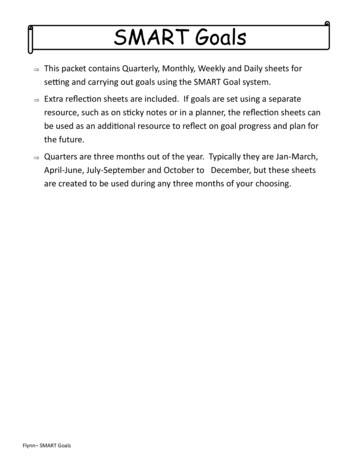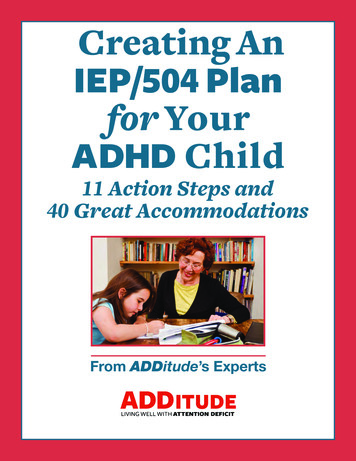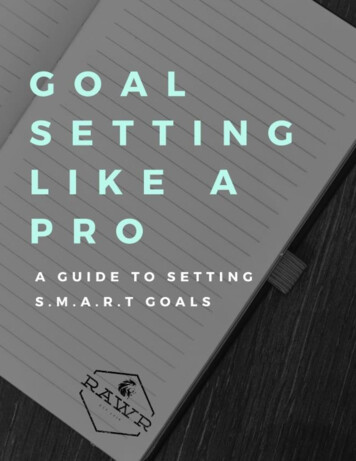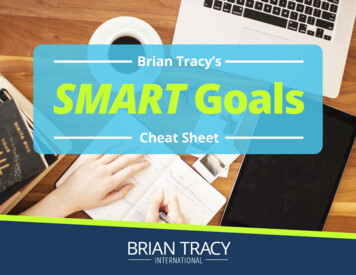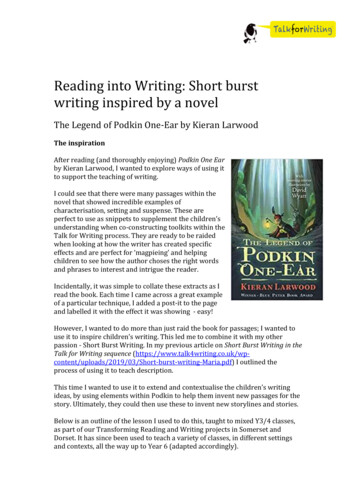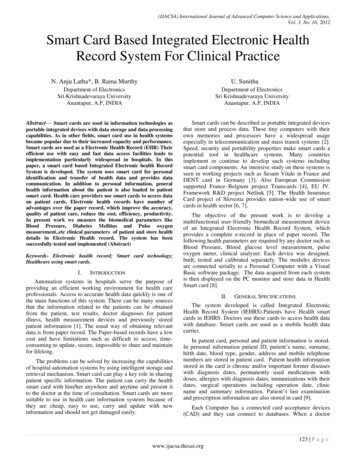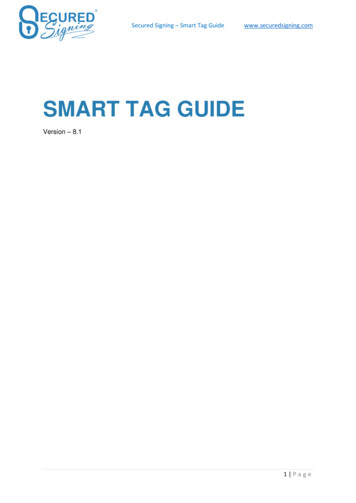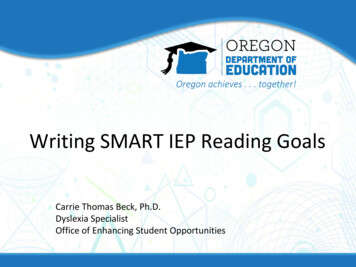
Transcription
Writing SMART IEP Reading GoalsCarrie Thomas Beck, Ph.D.Dyslexia SpecialistOffice of Enhancing Student Opportunities
Today’s Objectives Set the stage: discuss writing IEPs in the Endrew era Learn the steps in an “if-then” diagnostic assessmentflowchart to determine a student’s present level ofperformance Walk through a student case study Set appropriate IEP goals based on a student’s presentlevel of performance Address common questions from the field Share resources
De Minimis Benefit Not Enough Endrew F. v. Douglas County School District R1,798 F.3d 1329 The Supreme Court rejected some lower courts’determinations that “merely more than deminimis” benefit is sufficient to provide FAPE. Rather, Individualized Education Programs (IEPs)must provide students with disabilities theopportunity to make appropriate progress.4
The Purpose of the IEP “The IEP must aim to enable the child to makeprogress. After all, the essential function of an IEP is toset out a plan for pursuing academic and functionaladvancement”(Endrew F., 2017, p. 11) “To meet its substantive obligation under the IDEA, aschool must offer an IEP reasonably calculated toenable a child to make progress appropriate in light ofthe child’s circumstances.” (Endrew, 2017, p. 16)5National Center on Intensive Intervention
Appropriately Ambitious “A child’s IEP need not aim for grade-leveladvancement if that is not a reasonableprospect. But that child’s educational programmust be appropriately ambitious in light ofhis circumstances, just as advancement fromgrade to grade is appropriately ambitious formost children in the regular classroom. Thegoals may differ, but every child should havethe chance to meet challenging objectives ”
What Does This Mean for IEP Teams? Avoid procedural violations in the development of the IEPthat could, in and of themselves, constitute a denial of FAPE. Ensure meaningful parent involvement in IEP meetings. Base the present levels of academic achievement andfunctional performance on academic and functionalassessments and other relevant and meaningful data. Ensure that annual academic and functional IEP goals arechallenging, appropriately ambitious, and measurable.National Center on Intensive Intervention7
What Does This Mean for IEP Teams? Develop and implement special education services,related services, and program modifications that arereasonably calculated to enable a student to makeprogress appropriate in light of that student’s needs Continuously monitor and measure a student’sprogress using real dataNational Center on Intensive Intervention8
Goal Writing: A Non-ExampleWhat if you had a student (Ray) who just finished second gradeand: Scored in the 14th %ile on passage comprehension and lowaverage on reading recall Read 18 cwpm on DIBELS end-of-year 2nd grade ORF passage(goal is 72 cwpm) Read with 67% accuracy (goal is 96%) Scored at the 1st grade level on high frequency words Scored at the K level in word recognition, phonics and spelling10
Goal Writing: A Non-Example Is this an appropriate goal for Ray?When given a 3rd grade passage, Ray will read60 words per minute with 91% accuracy and beable to answer a variety of comprehensionquestions with 70% accuracy in 3 out of 4 trials.11
Goal Writing Need to assess underlyingfoundational skills to determineappropriate instructional goals in thearea of reading on the IEP12
Goal Writing What would be more appropriate goals forRay? First, we will need to collect more specificdiagnostic information . . .13
Types of AssessmentSource: CORE Assessing Reading: Multiple Measures 2nd Edition14
Diagnostic Assessment Plan for Students inGrades 2-12Adapted fromCORE AssessingReadingMultipleMeasures
STEP 1: Assess Reading Comprehension DIBELS 8th Edition: MazeCORE Reading Maze Comprehension TestAimswebPlus Reading ComprehensionEasyCBM Reading Comprehension
thDIBELS 8 Edition: Maze
Decision Point
Step 2: Assess Oral Reading Fluency DIBELS Oral Reading FluencyeasyCBM Passage Reading FluencyAimsweb Plus Oral Reading FluencyFastBridge CBMreadingMASI-R Oral Reading Fluency Measures
thDIBELS 8 Edition: ORF
Decision Point
Reading comprehension requires the activation and coordination of several skillsand processes. A compromise in one or more of these skills and processes can resultin difficulties in comprehending text.Kilpatrick, 2015, page 13622
Reading Comprehension Word Reading (we’ve ruled this out!)VocabularySyntaxBackground KnowledgeInferencingAttentionMetacognitionWorking MemoryVisual-Spatial-Perceptual SkillsKnowledge of Genre and Text StructuresKilpatrick, 2015
If Fluency Low, Assess Decoding ANDPhoneme Awareness
Common Misunderstandings About the Role ofPhoneme Skills and Phonics Skills in Reading Many children do not need phonics Phonemic awareness only relates to earlylearning of CVC words Phonemic awareness is not involved insight-word acquisition Phonemic awareness is not thought to beworth training after first grade If a student doesn’t develop phonemicawareness by second grade, they never willKilpatrick, 2019
Reading FluencyPoor fluency signals a problem,but what precisely is the problem? There is no clearevidence in the research literature to suggest thatfluency represents its own problem unrelated toother aspects of reading.Kilpatrick, 2015
Route to Reading FluencyLetter-Sound Knowledge PhonologicalBlendingPhonic DecodingPhonic Decoding Advanced PhonemicAwarenessSight VocabularyInstant and Accurate Word ReadingKilpatrick, 2015
Two Levels of Word Reading Deficits What distinguishes skilled word readers frompoor word readers?1. The ability to identify unfamiliar words bysounding them out.2. The ability to remember the words they read.
Step 3: Assess Phonic Decoding ANDPhoneme Awareness Phonic Decoding:–––––––HM Phonics/Decoding Screening TestCORE Phonics SurveyCORE Spanish Phonics SurveyReally Great Reading Diagnostic Decoding SurveysLetter Sound FluencyWord Reading FluencyNonsense Word Reading Fluency Phoneme Awareness:–––––DIBELS Phonemic Segmentation FluencyCORE Phoneme Segmentation TestCORE Phoneme Deletion TestCORE Spanish Phoneme Deletion TestPhonological Awareness Screening Test (PAST)
Phonic Decoding
Houghton Mifflin Phonics/Decoding Screening Test
Really Great Reading
Really Great Reading
Phoneme Awareness
Phonemic Segmentation Fluency
CORE Phoneme Segmentation Test
CORE Phoneme Deletion Test
Phonological Awareness Screening Test (PAST)
Phonological Awareness Screening Test (PAST)Syllable LevelD and EPreK to KOnset-Rime LevelF and GK to mid Grade 1Basic Phoneme LevelH and IEarly to Late Grade 1Advanced Phoneme LevelJ, K and LEarly to Late Grade 2Advanced Phoneme LevelMEarly Grade 3 and OlderKilpatrick, 2016
Decision Point
Remember: Both advanced phonemic awareness andphonic decoding are needed to build a largesight word vocabulary and facilitate fluentreading.
Reading AssessmentSpecial considerations:– Include a timed element to PA tasks– Include nonsense word tasks in addition toregular word reading– Timed nonsense words tasks a better assessmentof a student’s proficiency in phonic decodingthan untimed tasks– Students may sometimes mimic fluent readingKilpatrick, 201544
Student Case Study 8 years oldfemale3rd Gradermiddle of the school year
Step 1: Reading Comprehension(Maze)Results: DIBELS Next 3rd grade Maze Adjusted score of 0 GOAL 11 Well below benchmark
Step 2: Oral Reading FluencyResults: DIBELS Next 3rd Grade ORF Passage 1: 15 cwpm with 63% accuracy Passage 2: 13 cwpm with 65% accuracy GOAL 86 cwpm with 96% accuracy Well below benchmark
Step 3: Phonic Decoding andPhoneme AwarenessResults: DIBELS Next Nonsense Word Reading Fluency Score of 30 CLS and 1 WWR GOAL 54 CLS and 13 WWR at the beginning ofgrade 2 Well below benchmark for the beginning of grade 2 Student tried to use a sound out strategy for eachword. She often missed the vowel sound in the CVCnonsense words. She also had difficulty with wordswith b’s and d’s.
Step 3: Phonic Decoding andPhoneme Awareness (cont.)Results: Houghton Mifflin Phonics/DecodingScreening Test (See next three slides.)
Step 3: Phonic Decoding andPhoneme Awareness (cont.)Results: DIBELS Next Phonemic Segmentation Fluency Score of 43 sounds per minute GOAL 40 at the beginning of first grade “at benchmark” for beginning of first grade Student could fluently segment words such asmind, give, moon, and mouse, but had a difficulttime segmenting words with parts such as ds(birds), ong (song), all (hall), nce (since).
Step 3: Phonic Decoding andPhoneme Awareness (cont.)Results: Phonological Awareness Screening Test (PAST) 15/52 correct 12/52 automatic Mixed results. Student scored at the kindergartenlevel based on her performance across tasks, butwas able to delete and substitute phonemes atthe basic phoneme level when the phoneme wasat the beginning of a word (e.g., “Say grew. Nowsay grew, but instead of /g/ say /t/.”) which is afirst grade skill.
Present Level of Performance Describes the level of developmentor achievement and how the childapplies his or her learning in oneor more of the following areas: oralexpression, listeningcomprehension, basic readingskills, reading fluency, readingcomprehension, writtenexpression, math calculation, andmath reasoning.May include strategies applied inlearning and prefered learningstyles.Academic Performance Skills/activities not consideredacademic or related to thechild’s academic achievementConsidered routine everydayactivitiesExamples: communication,social skills, behavior,organization, self-care, fineand gross motorFunctional Performance
Using Progress Monitoring Data to WritePresent Levels of Performance Describe concrete, measurable skills that haverelevance to overall competence in a domain(e.g., reading, mathematics) Use valid and reliable assessment tools Focus on outcomes– What outcomes are desired?– What do present levels say about a student’s current progress towardmeeting those outcomes?– Compare to peers or proficiency standardsNational Center on Intensive Intervention58
Present Level of Performance - Decoding Case study student is currently reading 30 CLSand 1 WWR per minute as measured by DIBELSNext Nonsense Word Fluency (NWF) probes.The benchmark goal for the beginning ofsecond grade is 54 CLS and 13 WWR perminute.
Setting Goals Based on LogicalPracticesTeam members must know – How the goal was set– Why the goal was set that way– The intensity of the intervention provided to meet the goalKnowing the goal helpseducators select appropriateinterventions to help studentsreach the goal.
Specific – clearly focused; answers who, what, where, when, etc.Measurable – establishes concrete criteria for measuring progressAttainable – reasonable chance of being achievedRelevant – achievement will make a significant difference to thestudent’s ability to make progressTime Based – the goal has a begin date and time frames for progressmonitoring and follow-up
Example of SMART Reading Goal Reading Skill: Decoding Academic Standard: Know and applygrade-level phonics and word analysis skills indecoding words. Decode multisyllabic words. Sample IEP Goal: By the end of the IEP period,when given a list of 40 multisyllabic wordscontaining closed, open, consonant-vowel-e,and vowel team syllable types, the studentwill be able to decode 36/40 words correctlyas measured by teacher records.Understood.org
Goal Writing: RayStudent goals need to address the following areas: Reading: Phonological Awareness Reading: Advanced Letter-Sound Correspondences Reading: Word Reading Reading: Spelling Reading: FluencyGoal Area: Reading: Advanced Letter-Sound CorrespondencesGoal: Given a teacher-developed list of digraphs, trigraphs, and vowel teams, Ray will identify eachsound within one second with 95% accuracy by the next reporting period.Related Content Standards(s): CCSS.ELA-LITERACY.RF.3.3 Know and apply grade-level phonics andword analysis skills in decoding wordsHow will progress be measured: Teacher-developed lists of randomly ordered digraphs, trigraphs,and vowel teams.How progress will be reported, including frequency: Ray’s progress will be monitored weekly. Hisresponse time and accuracy will be graphed.64
Goal Writing: Case Study StudentStudent goals need to address the following areas: Reading: Phonological Awareness Reading: Advanced Letter-Sound Correspondences Reading: Word Reading Reading: Spelling Reading: FluencyGoal Area:Goal:Related Content Standards(s): CCSS.ELA-LITERACY.RF.3.3 Know and apply grade-level phonics andword analysis skills in decoding wordsHow will progress be measured:How progress will be reported, including frequency:65
Goal Setting: Case Study StudentGiven direct instruction in phonologicalawareness and phonic decoding, the case studystudent will be able to read at least 54 correctletter sounds (CLS) and at least 13 whole words(WWR) in one minute as measured by NonsenseWord Reading Fluency (NWF) probes by the nextreporting period.Progress monitor weekly using NWF probes.Graph CLS and WWR.
How to Determine an Ambitious butAchievable Goal
Four Steps for Setting a Valid Goal:1.2.3.4.Select a measure.Establish baseline performance.Choose a strategy for setting the goal.Write a measurable goal.National Center on Intensive Intervention, 2019
Select a Measure Single-skill measures (mastery measures) areless useful for monitoring students’maintenance of skills and progress across theschool year on a broad set of skills.General Outcome Measures (GOMs) areindicators of general skill success that reflectoverall competence on an outcome. (Acommon example of a GOM is acurriculum-based measurement – CBM.)
Goal Setting StrategiesThere are three validatedapproaches to setting goals:1. Benchmarks2. National norms for weeklyROI3. Intra-individual frameworkNational Center on Intensive Intervention, 201970
Must IEP goals utilize GeneralOutcome Measures (GOMs) only? The general recommendation from NCII is touse GOMs so as not to have to constantlychange the goal. However, it is appropriate touse mastery-based goals along with GOM goalsas needed. The goals help drive instruction.Teachers should write goals that reflect highquality instruction – and the goals should allowteachers to measure the impact of theinstruction.
Can goals be set below grade level? Goals for academic performance may be setbelow grade level, but the decision must be anIEP team decision. In general, IEP andintervention goals should be written at thelevel the student would be expected toperform at the end of the instructional period(i.e., 1 year for annual goals).National Center on Intensive Intervention, 2019
Standards-Based IEPs In 2015, the U.S. Department of Education issued a guidanceletter that made it clear that all IEPs must be tied to stateacademic dea/memosdcltrs/guidance-on-fape-11-17-2015.pdf) The guidance letter states a child’s IEP goals must align with“the state’s academic content standards for the grade in whichthe child is enrolled.” This requirement does not mean the child’s goals must aim formastery of grade-level expectations (but child’s educationalprogram must be appropriately ambitious in light of hiscircumstances as per Endrew F.)
2015 Dear College Letter:Example of a 6th Grader with SLD Whose ReadingFluency is at the 2nd Grade Level Team determines student should receive specializedinstruction to improve his reading fluency. IEP team estimates that with appropriate specializedinstruction, student could achieve an increase of at least 1.5grade levels in reading fluency. To ensure the student can learn material based on sixthgrade content standards, the team determines he shouldreceive modifications for all grade-level reading assignments. In addition, student would be provided with text to speechaccommodations.
Must an IEP only have one reading goal? Having more than one reading goal isabsolutely fine! There is no “right” number of goals - itdepends on the unique circumstances of thestudent.
When is it appropriate to useobjectives with IEP goals? Measurable short-term objectives for students workingtowards regular achievement standards may be included onthe IEP, but are not required. It is possible to write a broader IEP goal and have theobjectives address the subskills -- but make sure the goallends itself to collection of progress monitoring data. For students with disabilities who take alternate assessmentsaligned to alternate academic achievement standards (i.e.,Extended Assessment), the statement of measurable annualgoals also will include “a description of benchmarks orshort-term objectives” as per IDEA.
ODE’s Procedural Compliance ReviewStandard 26: PLAAFP Contains Academic Performance and Functional PerformanceThe most recent IEP includes a statement of Present Levels of AcademicAchievement and Functional Performance including all of the following:Input from parent(s) in the areas of academic achievement andfunctional performance, including concerns for enhancing the educationof their child; Present level of academic performance, including strengths, needs, andhow the student’s disability affects involvement and progress in thegeneral education curriculum, and including the student’s most recentperformance on State or district-wide assessments; and Present level of functional performance, including strengths, needs, andhow the student’s disability affects involvement and progress in thegeneral education curriculum, and including the results of the initial ormost recent evaluation. 34 CFR §300.320 §300.324
ODE’s Procedural Compliance ReviewStandard 31: Annual GoalsThe most recent IEP contains a statement of measurable Annual Goalsincluding academic & functional goals. 34 CFR §300.320Guidance for Standard Check the IEP for annual goals, written in measurable terms that describewhat the student can reasonable accomplish in a 12-month period. Check the IEP for evidence of a direct link between goal(s) and thestudent’s present levels of academic achievement and functionalperformance. The annual goals must relate to meeting student’s needs that result fromthe disability, meeting the student’s needs to enable involvement in andprogress with the general education curriculum, and meet othereducation needs that result from the disability. Measurable short-term objectives for students working towards regularachievement standards may be included on the IEP, but are not required.
ODE: Writing High-Quality IEPs Best Practices &Supporting Guidance Document Each goal must align with baseline data in the present levels ofperformance Goals may be related to academic or functional standards All areas of SDI must have at least one goal Students taking the Extended Assessment for a subject area must havemeasurable, short-term objectives or benchmarks as part of the goal A district may determine how to indicate alignment to standards (bydomain, strand, cluster, or standard language) in a way that is meaningfuland understandable to all team members
Determining Needed SDISpecially Designed Instruction (SDI) (and other needed supports)are included in the IEP in order to enable the student to accessthe general curriculum.Develop Present LevelsSet Measurable Annual GoalsThe IEP hinges on welldeveloped present levels thatpaint a current picture of thestudent’s educationallandscape.Annual goals help the teamestablish what the IEP teamwants the student to know orbe able to do in one year’stime.What are the student’sstrengths?What are the student’schallenges?How does thatcompare to a typicalpeer?They are based on the pictureof the student the teamdeveloped when constructingthe Present Level statement. Determine SupportsNeeded to Reach GoalsOnly after the Present Levelsand Measurable Annual Goalshave been set can the IEPTeam determine the supportsthat the student needs (e.g.,SDI, Related Services,Accommodations). Supportsin an IEP help a studentmaster their IEP goals so theyare able to access the generalcurriculum.
ODE: Writing High-Quality IEPs Best Practices &Supporting Guidance Document (cont.) Goals should be written to meet the S.M.A.R.T. Goals Guidelines: (S)Specific, (M) Measureable, (A) Attainable, (R) Relevant, and (T)Time-bound Mode of measurement is the evidence or artifacts the team uses todetermine progress and attainment of goals, such as observation data,curriculum-based assessments, student work samples, behavioral data,self-charting data, or formative assessments Progress for each goal should provide enough information for the teamto identify current levels of performance in the goal rd-IEP.aspx
Approach IEP goals with a two-fold purpose foreach student:1.2.Providing access to grade/age levelexpectations; andBuilding the foundation for futureindependent performance.
Resources
National Center on Intensive urce/high-quality-academic-IEP-goalsBailey, T.R., & Weingarten, Z. (2019). Strategies for setting high-quality academic individualized educationprogram goals. Washington, DC: National Center on Intensive Intervention, Office of Special EducationPrograms, U.S. Department of Education.
National Center on Intensive Interventionhttps://intensiveintervention.org/
Goal instructional-planning-dbi-training
Using Informal Academic Diagnostic Data to Guide nt-using-data-guide-intensive-instruction-dbi
Iris Centerhttps://iris.peabody.vanderbilt.edu/
Developing High Quality 01/#content
How Administrators Can Support theDevelopment of High-Quality 02 /
Kilpatrick, D. (2019). Why Phonemic Proficiency is Necessaryfor All Readers. Webinar sponsored by s/
https://sitesed.cde.state.co.us/course/view.php?id 132
For Additional Information: /SpecialEducation/RegPrograms BestPractice/Pages/Dyslexia.aspx Contact:Carrie Thomas Beck, Ph.D.Dyslexia SpecialistOregon Department of 3
DIBELS Next Nonsense Word Reading Fluency Score of 30 CLS and 1 WWR GOAL 54 CLS and 13 WWR at the beginning of grade 2 Well below benchmark for the beginning of grade 2 Student tried to use a sound out strategy for each word. She often missed the vowel sound in t
